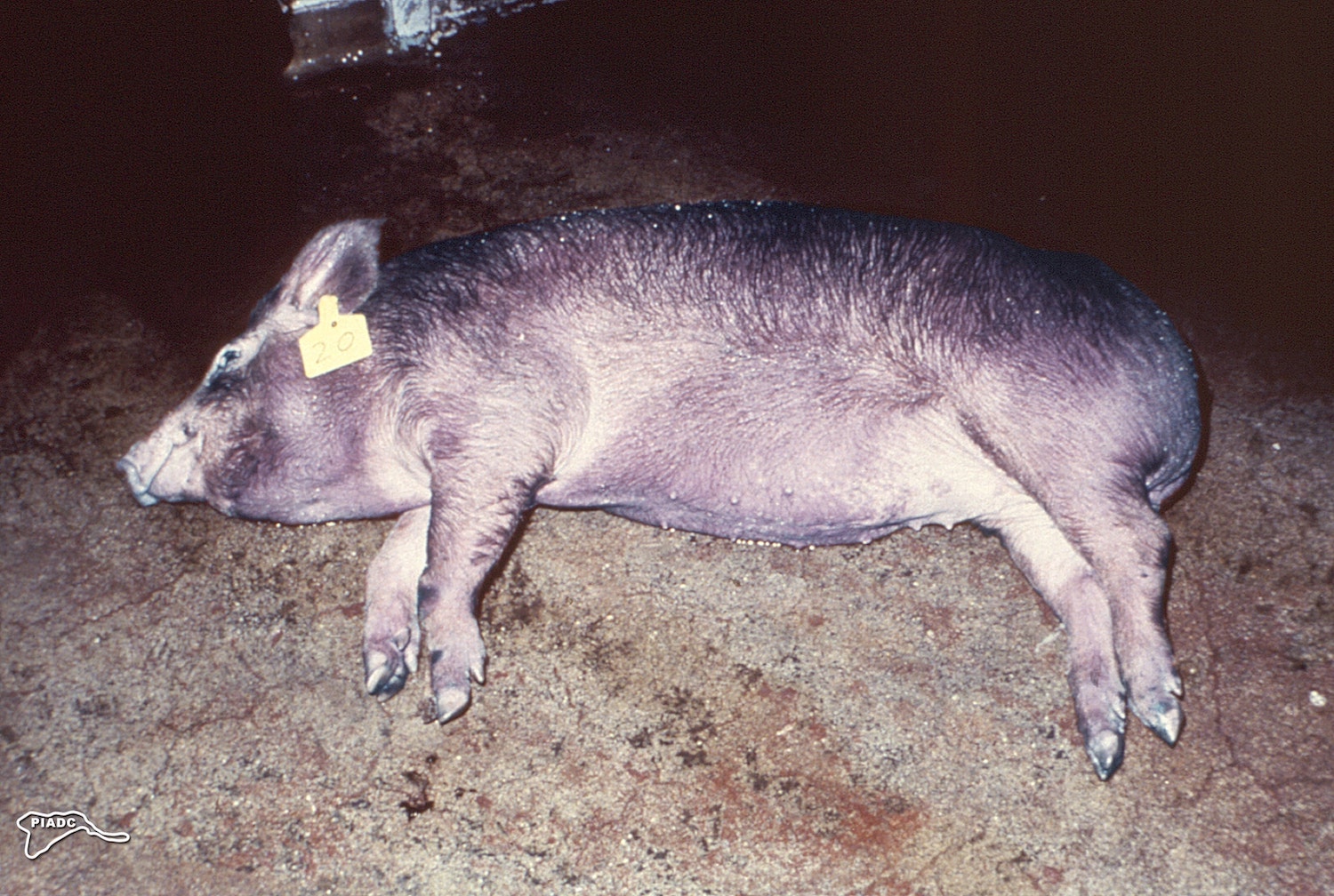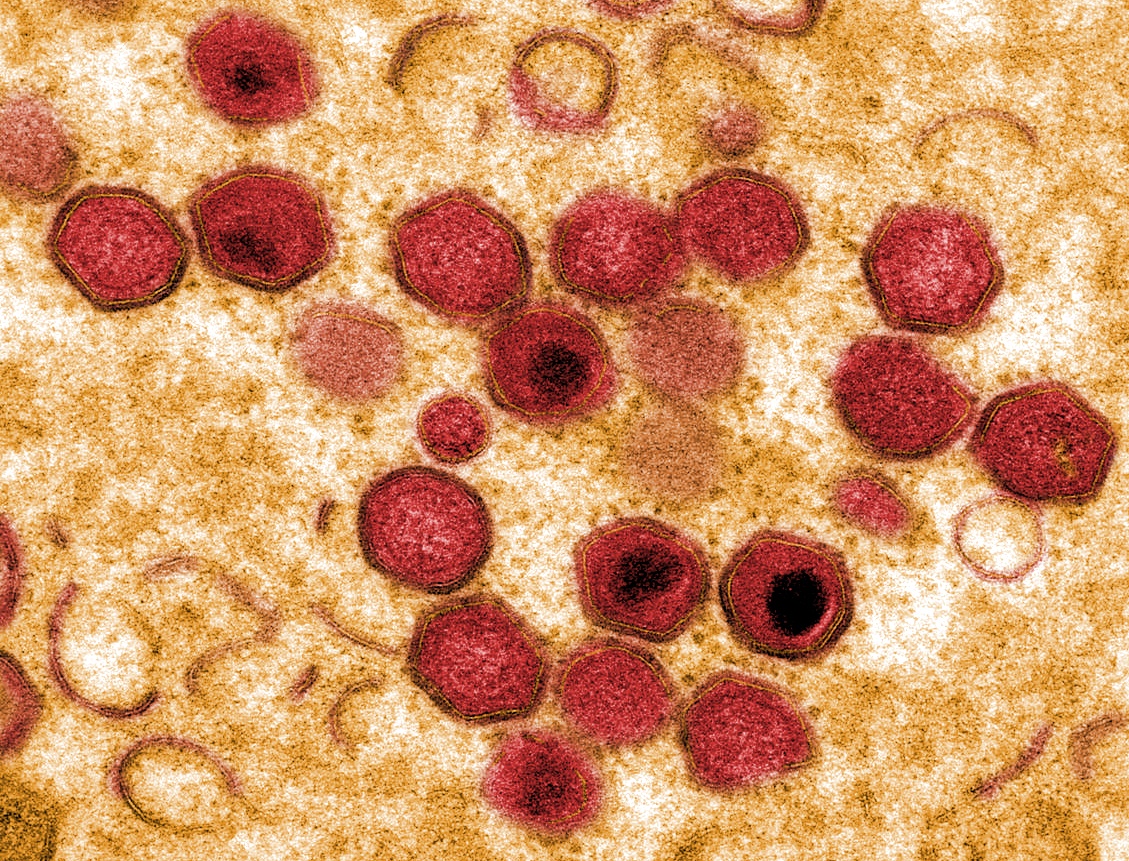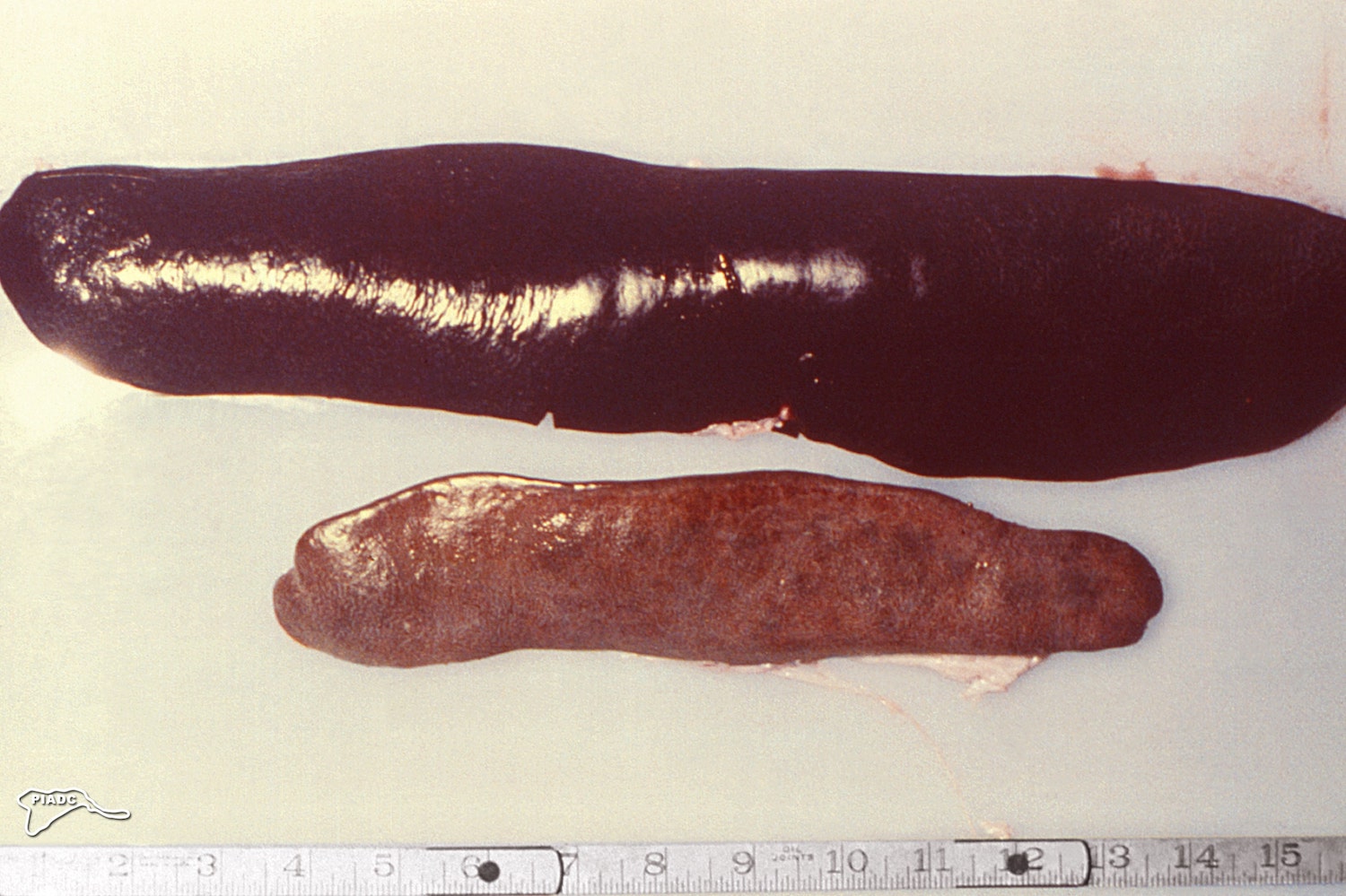
Google Maps
The world’s worst pig virus is decimating the world’s biggest herd, and it shows no signs of slowing down. African Swine Fever kills almost all infected animals within a week or two. It’s impossible to treat, and there is no vaccine. And it has already had a devastating impact on the global food supply.
The United States has not seen an ASF outbreak so far, though some veterinarians say it’s only a matter of time before the fever crosses the ocean. But on one tiny, isolated island in the easternmost waters of New York, the virus is alive and well. Scientists at the Plum Island Animal Disease Center are racing to develop a vaccine to inoculate U.S. herds against the disease.

A pig exhibiting symptoms of African Swine Fever
CDC Public Health Image Library
African Swine Fever was first found in China—the world’s largest pork producer—last August, and it quickly spread to every province in the country. Official numbers show 1.1 million pigs have been culled there, but experts believe the real number may have reached 200 million, or more than a third of the country’s herd. It hopped the border into Vietnam in February, where it has since led to the death or culling of 2.8 million pigs—10 percent of the country’s herd—prompting calls for a nationwide state of emergency. In recent months, cases have cropped up in Laos, Cambodia, Mongolia, and North Korea.
Despite clear urgency, the rollout of a viable vaccine will take years. In the meantime, the United States Department of Agriculture is rushing to formulate a plan to keep ASF from wreaking havoc on the U.S. pork supply. And that means teaching veterinarians all over the country how to identify pigs with the disease. Earlier this summer, roughly 30 or so gathered on Plum Island to train for the task. They were prepping for a pork-pocalypse, and it started with a necropsy.
Between Connecticut and Long Island lies a three-mile-long island, shaped a little like a pork chop. It’s home to all kinds of government projects that have nothing to do with foreign animal diseases: The Defense Advanced Research Project Agency (DARPA) runs a simulation exercise to restart a hacked power grid every six months or so. New York National Guard soldiers used the island last spring to practice containing a simulated release of nerve gas. Search-and-rescue teams fly in from all over the country to practice extracting people from the ruins of a decaying military fort, which simulates a disaster zone. A futuristic-looking seismographic dome can detect nuclear activity ten thousand miles away. It’s kind of like a playground for end times.
But the main activity revolves around the Animal Disease Center, a storied laboratory that was opened in the 1950s by the United States Department of Agriculture. Like any good secluded government project, it has long been plagued by rumors that its researchers, say, experiment with bioweapons, breed mutant dogs, even tinker with the actual plague. Given how opaque the research center can be, it’s sometimes hard to tell whether the rumors are rooted in truth.

A microscopic image of African Swine Fever
The Pirbright Institute
A 2004 letter to the editor published in The New York Times intimated that reader Wiltraud Salm’s husband had almost been killed by a Bubonic-plague-adjacent disease that actually made its way off the island. Tularemia, the Asian rodent disease he caught, is spread through insects. Declassified documents showed that the lab on Plum Island had been cultivating bacteria that matched his diagnosis. He had often walked in the woods near the bay that separated the island from the shore, she wrote. An escaped insect could have flown the few miles across the water or hitched a ride on an unwitting ferryman.
Other rumors have been even more enduring. In the 1970s, a cluster of 39 children living on the Connecticut shoreline contracted the tick-borne illness that came to be known as Lyme disease. You can see the town of Old Lyme, where the outbreak occurred, from the ferry to Plum Island. Whispers spread that the ticks were released accidentally by scientists working to develop biological weapons. (A spokesperson for the Department of Homeland Security dismissed the story when I asked about it, pointing me to 5,300-year-old Otzi the Iceman, a suspected Lyme sufferer.)
This is the only place in the country vets will be able to see African Swine Fever in the flesh before they’ll potentially have to recognize it in the field.
But the doomsday scenario that all these veterinarians traveled here to prevent has nothing to do with the power grid or bioterrorism by tick. (Although it might have a little to do with the latter: African swine fever can be transmitted through soft ticks, meaning it could hypothetically be introduced by malicious foreign agents hoping to disrupt the ag economy. The people I interviewed for this story seemed much more concerned that the virus would enter the U.S. by accident, though, than by way of a Trojan tick).
Yet the vets visiting Plum Island are arguably practicing exactly the same thing as their DARPA counterparts down the road. They all work for the government or the military, and this is the only place in the country they’ll be able to see African Swine Fever in the flesh before potentially needing to spot it in the field. Once they leave the island, these vets will be certified Foreign Animal Disease Diagnosticians—and they’ll be the country’s first responders if an outbreak ever reaches U.S. soil.
The pigs arrived a week or so before the vets descended on Plum Island for FADD School—the two-week course that mints new Foreign Animal Disease Diagnosticians. There’s a delicate balance to inoculating animals with a fatal virus for educational purposes: You can’t inject them too early, or they’ll die before the students have a chance to observe their symptoms (and, later, to perform a necropsy—the animal version of an autopsy). You also can’t inject them too late, or they’ll stay perfectly healthy for the duration of the visit, only to drop dead soon after. The ASF-afflicted pigs will be observed each day as the virus progresses, then euthanized and examined more closely.
The tricky thing about diagnosing a potential case of ASF is that it can look a lot like other more common diseases.
Each day, after spending the morning in lectures with titles like “Screwworm” and “Ticks of Importance to the U.S.,” FADD students enter the secure biocontainment area where animals are kept. During their 10 days on the island, they’ll learn how to identify all kinds of diseases they might never see in the field. The school has been running since the 1970s, soon after the United Kingdom’s major Foot and Mouth Disease outbreak. But now, the top of everyone’s mind is ASF.
FADD attendee Ellen Yoakam, a veterinarian for the Ohio Department of Agriculture who covers an area in the north central part of the state, says her office has been hearing regularly from worried farmers. “I think ASF is the biggest concern right now. It’s a pretty hot-button item, just watching everything that’s going on in China,” she says.
After lunch, the veterinarians will make the rounds, observing animals in various stages of diseases they hope never to see outside the lab. Rabbits, chicken, cattle, and pigs have been brought onto the island for the occasion.
The tricky thing about diagnosing a potential case of ASF is that it can look a lot like other more common diseases. Symptoms can include high fever, decreased appetite, skin lesions, and diarrhea, just like the common porcine epidemic diarrhea virus or Classical Swine Fever. (Farmers are encouraged to report any suspected outbreaks to their local animal health officials, as it’s much easier to test a false positive than to contain an outbreak that’s festered for days.) ASF’s real calling card is its mortality rate: It claims almost all infected animals within 7-10 days of showing symptoms, and some drop dead much earlier—without showing any outward signs of illness.

Top: The spleen of a pig with African swine fever. Bottom: Spleen of a healthy pig
CDC Public Health Image Library
At FADD school, the days end with necropsies, then a shower and a ferry ride back to Long Island before dinner. On the day I visited, participants would be taking a close look at an animal that had been infected with Foot and Mouth Disease. African Swine Fever was on tap for the following week.
The necropsy is arguably the most important part of the whole course. If a disease’s hallmark is its high mortality rate, the pigs these veterinarians may someday handle will likely already be dead. In order to properly diagnose ASF, field diagnosticians will rely on their training at FADD school and samples taken from the animals. A huge part of the Plum Island training course is about taking accurate samples—in many cases, several from each organ—to ensure an accurate lab diagnosis.
“It’s really hard to forget when you physically put your hands on it.”
Diagnosticians will also need to develop a gut-level sense of whether or not the diseased animal in question might really have been infected with ASF. They’ll be looking for a handful of telltale signs during the necropsy: a spleen that’s doubled or tripled from the size of a cucumber to the size of a football, or a set of swollen lymph nodes in the abdominal cavity. There are other, less easily describable changes that happen to an infected animal’s body too. The texture of the spleen changes from normal (for a spleen) to what Rebecca Ita, a veterinary epidemiologist who was also attending FADD School, described as “friable”—a term of art meaning, roughly, crumbly. “It’s really hard to forget when you physically put your hands on it,” she says.
If a farmer suspects a case of African Swine Fever, she is encouraged to call a foreign animal disease hotline (1-866-536-7593, for the record). The operator will dispatch a Foreign Animal Disease Diagnostician to the farm or slaughterhouse within 24 hours, who will then examine the animal or animals in question. Yoakam says Ohio veterinarians perform about one investigation a week, typically at swine processing facilities.
From there, the diagnostician makes a judgment call: Most of the time, they’ll rate the likelihood of ASF positivity as Priority Two or Priority Three. Priority Two means a sample carries a high degree of suspicion but a low risk of mass trade disruption (a single wild boar, for instance, as opposed to an animal in a slaughterhouse that processes thousands of animals per day). Priority Three refers to a lower index of suspicion. In either case, the diagnostician will take a bunch of samples and send them out to nearby labs and to Plum Island, usually via FedEx.
If ASF is confirmed in the United States, it’ll initiate a 72-hour halt of all swine movement in the country. No one knows precisely what will happen next.
But if the diagnostician rates the likelihood of the presence of ASF as Priority One—high index of suspicion, high risk of trade impact—samples will get airlifted from the farm to Plum Island on a private jet. (So far, this hasn’t happened.) If it’s a weekend, the island will run special ferries to pick up the scientists, who assemble immediately and begin running tests. “It’s a pretty well-oiled machine. The moment that sample gets here, we have people lined up in the lab ready to … begin the testing,” says Dr. Kim Dodd, director of the Foreign Animal Disease Diagnostic Laboratory.
From there, it takes three hours to get what they call a “presumptive positive,” or an alarming-enough result to trigger a few phone calls up the chain of command. When Dr. Jack Shere, the U.S. Chief Veterinary Officer, receives one of those calls, he starts communicating with the Secretary of Agriculture and the public affairs office.

The exterior of Plum Island Animal Disease Center
USDA
Meanwhile, back at the lab, Dodd will run a battery of confirmatory tests to eliminate all doubt that the sample in question is African Swine Fever. All the while, Shere is coordinating a response team. “If we get clinical signs and it looks like the real deal,” he says, “we have mobilized our workforce to get there and start to begin to prepare to deal with the disease on location, which is quarantined by the state. We’ve got equipment on the way for euthanasia. We’ve got equipment on the way for cleaning and disinfection, the works. It’s on, it’s mobilized.” Once the diagnosis is confirmed, Shere says the goal is to let the public know within about 16 hours.
If ASF is confirmed in the United States, it’ll initiate a 72-hour halt of all swine movement in the country. From there, scientists will work to identify the source of the outbreak and scramble to contain it. No one knows precisely what will happen next.
Of course, emergency preparedness is just one sliver of the broader efforts on Plum Island to prevent ASF’s spread. Dodd’s team is also working to promote an active surveillance strategy, proactively testing samples that aren’t necessarily suspected of harboring the virus. This effort has increased nationwide sampling from 13,000 samples a day to 38,000. There are also other, potentially easier ways to step up surveillance without sticking needles into live animals: Pigs like to chew on ropes, and some evidence indicates that a rope hung in a pen will collect mouth fluid samples from 75 percent of the occupants within 20 minutes or so. Some day, a similar method may be used to screen early for ASF.
But the holy grail will always be a vaccine. Dr. Manuel Borca, a research biologist on Plum Island, has been working on this very thing. The concept is simple: Inoculate an animal with a weakened version of a virus, and they’ll develop antibodies that render them immune to a larger dose. “It takes years,” Borca says, adding that he’s been working on these questions for two decades.
For now, it’s a waiting game on Plum Island.
Unfortunately, finding a vaccine is much easier said than done: Borca has spent the last 10 years developing a methodology to identify vaccine candidates, a process that has led to three viable options that have already been successfully administered to ASF-positive pigs. Borca’s method involves deleting selected genes one or two at a time.
The next step is to ink a deal with a private company that can foot the bill for the years of R&D that lie between the vaccine candidates and the mass market. There’s good reason for all the precaution: In 1957, pigs in Portugal contracted ASF after eating airplane leftovers that contained contaminated pork. They were given a vaccine, which appeared to stop the spread, but later they developed a chronic, non-fatal version of the illness. If we aren’t careful, the cure can become the disease.
For now, it’s a waiting game on Plum Island. I asked everyone I interviewed if they cared to speculate if and when we’d see the virus hit U.S. herds. Most declined but said they were very concerned about it. “If you talk to people, they’ll say it’ll be here in a year. I don’t believe that,” said Shere, the Chief Veterinary Officer, adding that the U.S. has successfully prevented the introduction of Foot and Mouth Disease for decades.
Still, every morning at the leadership operations meeting, Dr. Dodd gives the same update: “We stand prepared. We’re ready if it comes.”
Update 6/28/2019: We have updated the story to clarify a quote that may have implied the USDA will not act immediately if it finds an ASF-positive test result. The agency will not hesitate to respond to any suspected outbreaks of ASF










